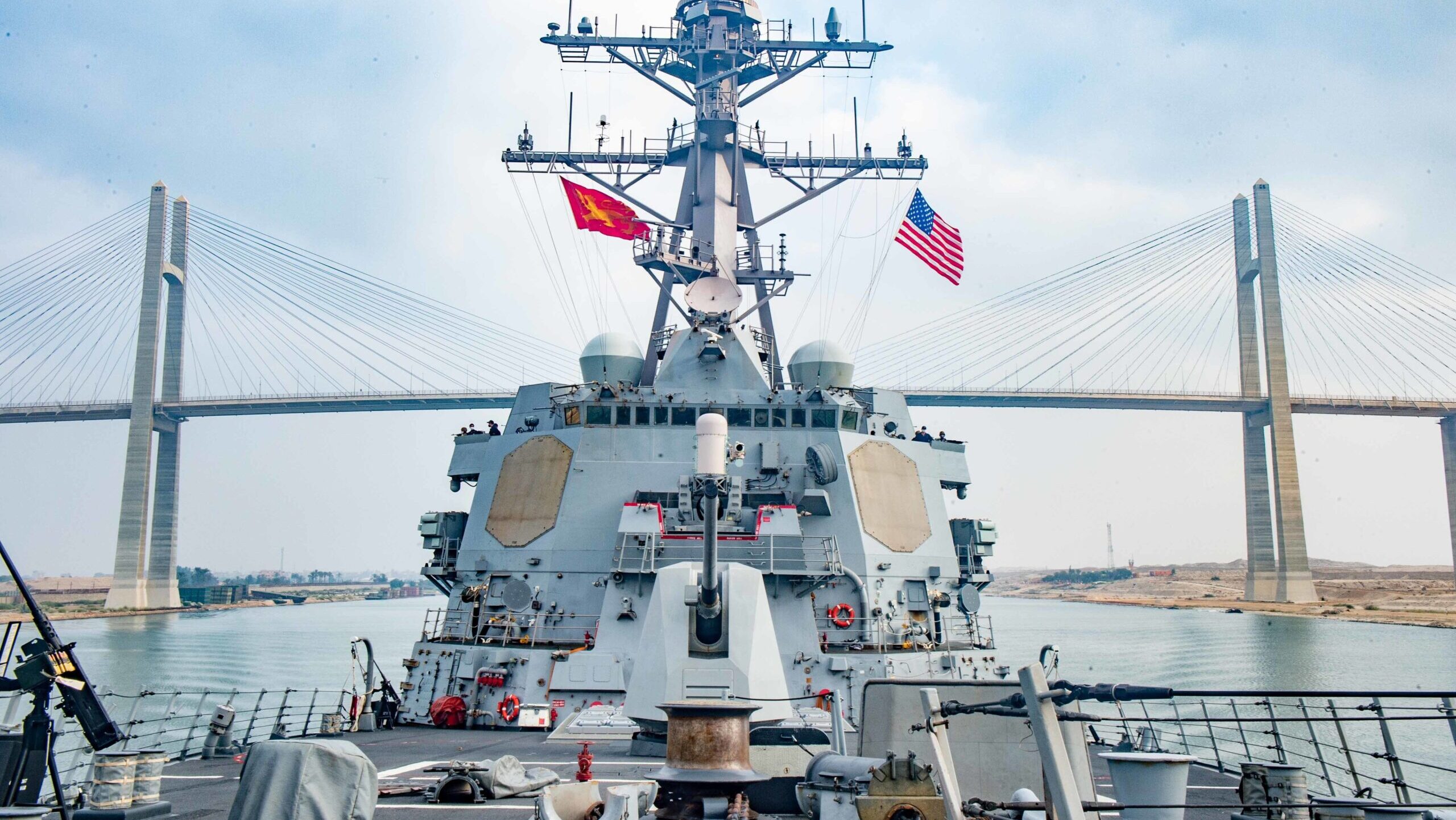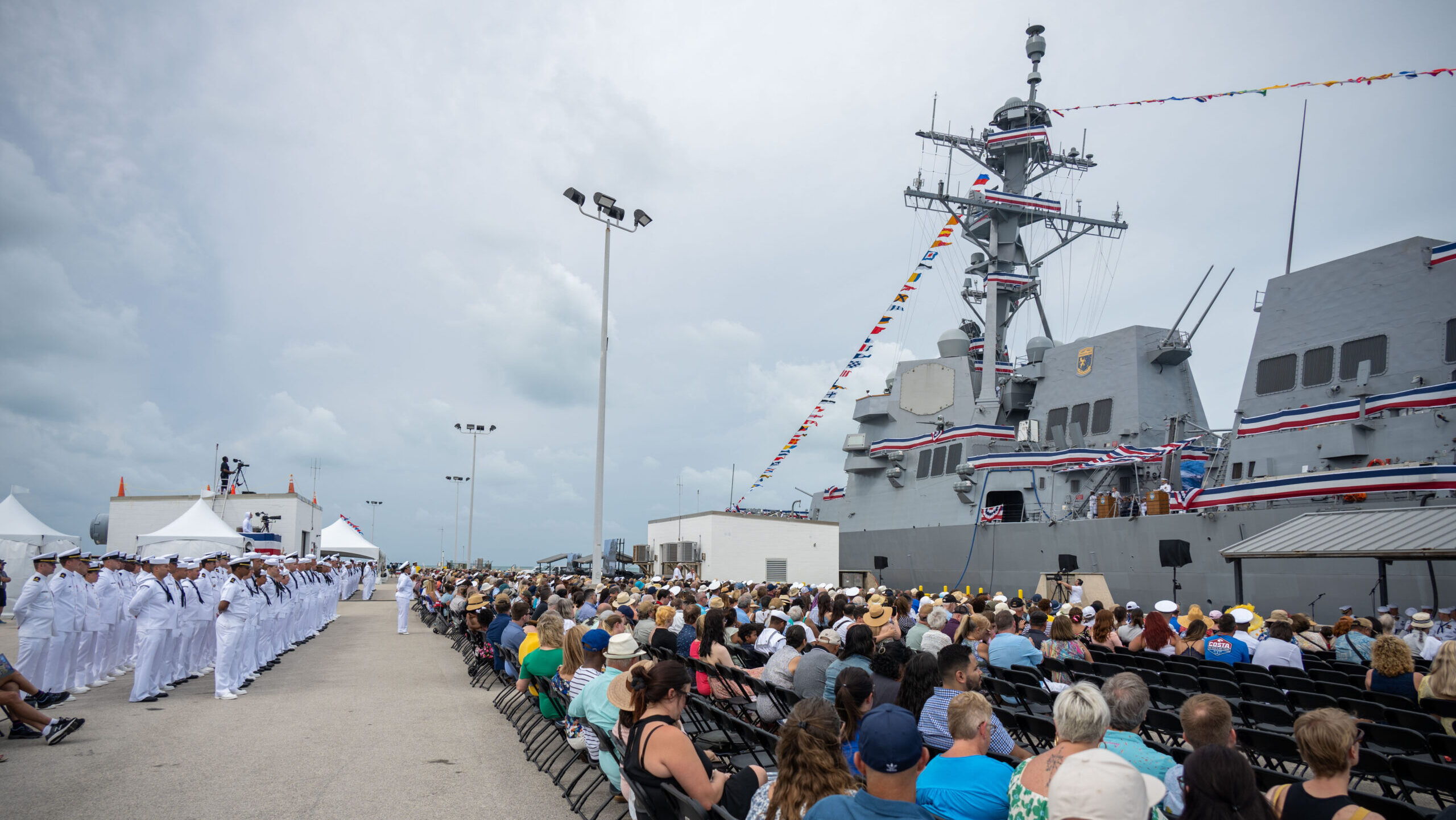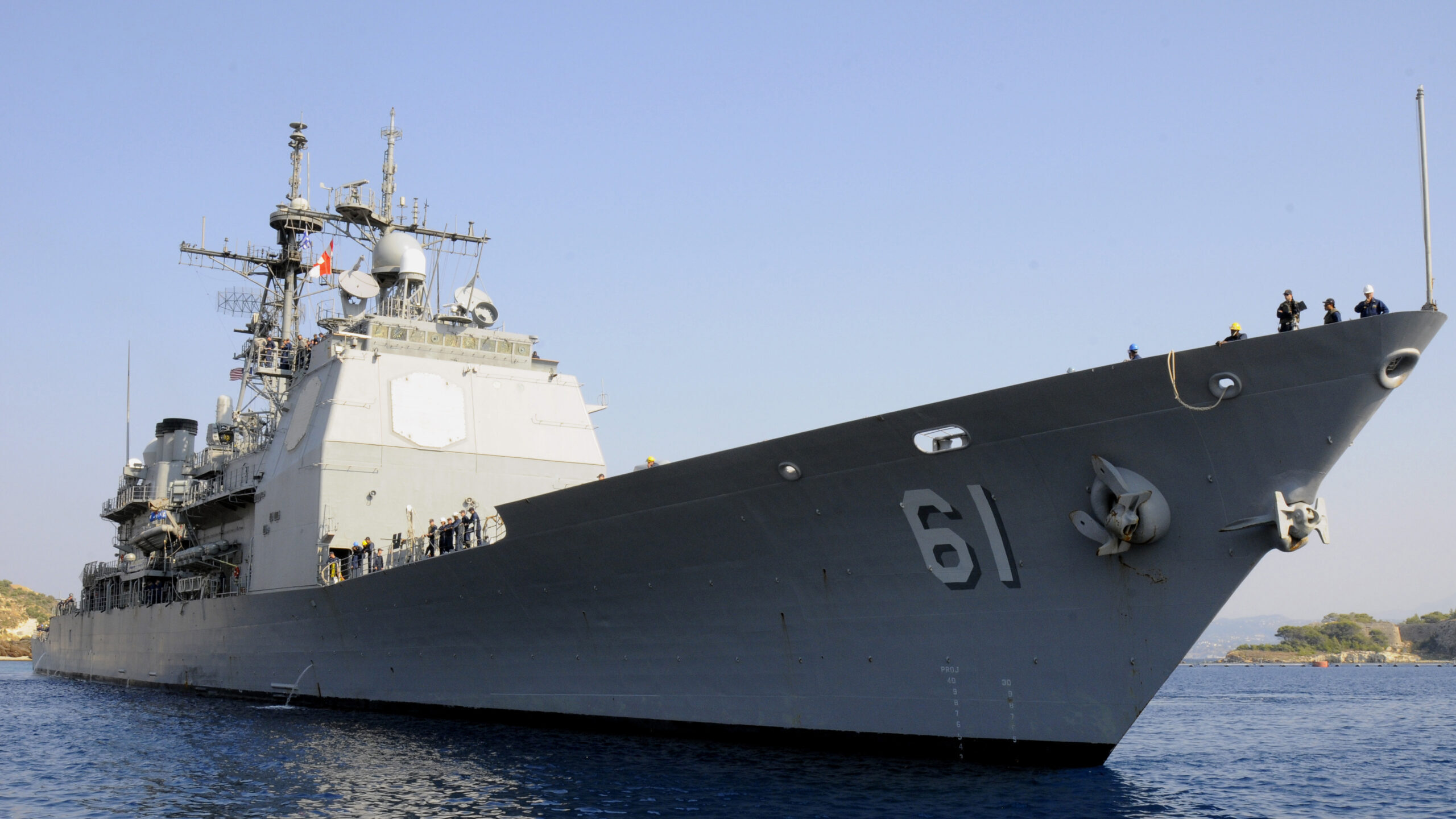
The guided-missile destroyer Winston S. Churchill (DDG-81) transits the Suez Canal, Sept. 10. Winston S. Churchill is one of a few ships now installed with hardware associated with the Navy’s earliest version of the Integrated Combat System. (US Navy photo by Mass Communication Specialist 3rd Class Louis Thompson Staats IV)
DAHLGREN, Va. — A crew of engineers load a rack packed with computing hardware onto a barge floating just off shore. Shortly after they return to shore, an underwater explosion goes off, blasting water into the air, pitching the barge and violently shaking the rack full of technology vital to the future of the US Navy.
The engineers were never in harm’s way, but there’s no immediate clarity on the all-important equipment. Later, as service officials inspect the individual pieces of gear, they are pleased to find that everything has survived. Commercial, off-the-shelf ruggedized hardware can apparently take a wallop simulating what the devices could experience had they been housed in the hull of a ship in the middle of naval warfare — and they could be called to, if a specialized Navy program gets its way.
The Navy and industry staff who requested the shock trial are part of the Foundry, a team headquartered within the Program Executive Office for Integrated Warfare Systems and led by Capt. Brian Phillips. The captain, his staff and more than a dozen industry vendors are collectively tasked with assembling and integrating the hardware that will make up the Navy’s future Integrated Combat System, a common computing environment on every warship that will standardize both how sailors operate their equipment and how engineers ashore push software updates to ships at sea.
The theory, staffers told Breaking Defense during an exclusive Feb. 1 tour, is that by refitting warships with computing hardware largely sourced from the commercial sector — think hard drives, servers, and cables — the Navy can reap the benefits of an already well-established supply chain while allowing the fleet to receive over-the-air software updates using the same practices as America’s tech giants.
Now, after years of prototyping on ships such as the former cruiser Monterey (CG-61) and some unmanned surface vessels, the Foundry, in partnership with PEO IWS’s software factory known as the Forge, is beginning to roll out the earliest versions of ICS on operational ships: the destroyer Winston Churchill (DDG-81) received the upgrade last year and the destroyer Lenah Sutcliffe Higbee (DDG-123) is wrapping up its installation this month.
It’s a start. The Navy plans to eventually install ICS on every ship in the surface fleet — destroyers, frigates, carriers, unmanned vessels. But the team’s success may ride on its ability to convince the rest of the Navy to abandon some of the outdated practices that have long dominated how the Pentagon buys its tech.
RELATED: App Store For Warships: Inside the Navy’s Project To Revamp How The Fleet Gets Software
Historically, the Navy’s view is that its mission has been unique and that it would be impossible for commercial industry to apply its standard technologies and methods to warfighting, said Lt. Cdr. Brandi Gilbert, one of Phillips’ deputies. “What we’ve observed going through and working with different industry partners is yes, we’re a little special. We’re a little [unique], but we’re not as different from industry as we initially thought.”

Sailors and civilians attend the Lenah Sutcliffe Higbee (DDG-123) commissioning ceremony in Key West, Florida, May 13, 2023. (U.S. Navy photo by Mass Communication Specialist 1st Class Michael B. Zingaro/Released)
Counting On COTS
A key premise of the Foundry is relying on commercial off-the-shelf (COTS) computing equipment, an idea that was once anathema to the Pentagon which historically has relied on boutique, customized platforms for just about everything.
The military’s affinity for customizable equipment may have worked when industry’s capabilities lagged the military, but that time has long since passed. The computing hardware Phillips needs to install onboard Navy ships has been refined and mastered by commercial tech giants.
“The technology that we’re taking is really technology that’s coming from the industry side, that has been out there and we’re now applying it to warfighting,” Phillips told Breaking Defense at the Foundry’s headquarters, an unassuming building just a few miles from the entrance to Naval Surface Warfare Center Dahlgren.
“The world has become much more dynamic,” he said. “It changes much more quickly. We’ve really had to put a lot of thought into how do we incentivize industry … and empower them to sort of unleash their power to give us the technology we need, rather than dictating everything to them?”
Flanking Phillips on either side as he spoke was a sizable crew, including his uniformed deputy, civilian Navy staffers as well as several contracted engineers. (Two firms — Red River, a New Hampshire-based IT services and consulting firm and Integrations Services Inc, based in Dahlgren, Va. — are responsible for integrating the numerous devices that will make up the Navy’s ICS.) The room itself was littered with computer workstations, tables with various hardware displayed and, for a jaunty touch, a Jolly Roger hung ironically in the background as decoration.
Among the devices displayed is a cable management solution that the Red River engineers were developing for shipboard server racks. The problem at hand was that an excessive number of cables wired throughout the tight confines of a dimly lit warship made it difficult for sailors underway to troubleshoot problems and for contractors ashore to make modifications when the vessel is in port.
The solution, the industry engineers proposed, was to use a combination of high-density fiber cables and a modernized cable plant configuration to reduce the “rat’s nest” of wires and make the set up easier to manage moving forward.
The captain compared the change to adding electrical sockets to a room. The Navy’s old way effectively required them to re-wire the whole room just to change one burnt out bulb. The new way only requires a sailor to change the light bulb itself.
The high-density fiber is so common in commercial industry that the engineers said a variant of it is called a “Taylor Swift cable” because it is frequently used at the pop star’s concerts. Meanwhile, the cable plant makes use of electrical engineering methods already widely utilized by a range of devices and buildings ashore — but not Navy ships, evidently.
What mattered to Phillips however was that his industry contractors were able to design the fix with little bureaucracy to cut through. It’s a freedom the captain is intentionally granting to the contractors in the spirit of allowing industry to find solutions for the Navy, rather than the military dictating what may not be the optimal path forward. When they presented the idea to Navy leadership, the question was simple: Do you want to do it the old way or do you want the modernized solution?
At the end of the day, the Navy is hierarchical, and the top brass will always get the final say on which changes go to sea and which ideas remain prototypes ashore. In this case, the service opted for industry’s solution.
One of the engineers on the tour quipped he would have been “disappointed” more than shocked had the service rejected the change. Indeed, it also wouldn’t have shocked Phillips because the scenario epitomizes some of the cultural barriers he said he is trying to break through at the Foundry.
“In the past — the old business model, we would have taken” the rat’s nest, the captain interjected. “We would have probably told them they were crazy for even proposing this to us.”

The guided-missile cruiser Monterey (CG-61), which has since been decommissioned, was an early test bed for the Navy’s Integrated Combat System. (U.S. Navy photo by Seaman Chelsy Alamina)
Going Deeper Than The Surface (Fleet)
At a surface level, the Navy hopes its Integrated Combat System will provide a common operating environment for sailors from ship to ship as well as the ability to rapidly transmit software upgrades to the fleet. But the Foundry staffers said there are multiple second- and third-order benefits to their approach.
For example, the shock trial involving the barge and a server rack filled with commercially available devices, shown on video to Breaking Defense during the tour, succeeded without the Navy asking any of the relevant original equipment manufacturers (OEMs) to modify their gear. Foundry staff attributed this to the fact that making devices rugged has become in the best interest of many commercial technology companies.
“If you look at technology in the last four to five years, you used to really have to repackage things to survive shock and vibration,” one engineer said. “But all the companies, Dell, HP, Cisco, have moved into … cell phone towers and ships and stuff like that. So, the quality and the ruggedness of that equipment has improved over time.”
The bottom line is that if the Navy orders a unique device and it breaks, the service must either rely on spare parts or wait months before the OEM produces a new one. If an otherwise commercially available device from Dell or Cisco breaks, those companies already have thousands of spares being made and shipped daily.
Even the act of just bringing hardware aboard the ship has room for improvement. The service’s historical method for installing computing gear onto ships is to package it inside what the engineers called a “2,000-pound box” — think of a structure akin to a vending machine or a telephone booth — and haul it aboard all at once.
“That’s why they have to cut a hole [in the hull], because you can’t turn a corner with that thing,” one of the engineers said. But the individual commercial devices the Foundry is integrating are relatively small and made to be plug-and-play, so “two people can lift it up, take it onto the ship, pull out the old one, put in the new one,” he said.
At the last stage of the tour, the engineers demonstrated some software monitoring tools that, once a ship is equipped with the right hardware, could be used to help sailors and Navy staff ashore monitor the vessel’s condition.
Again, the advent of such tools is no surprise to commercial industry — private companies hire relatively small teams of people to monitor massive data warehouses using similar methods, the engineers said. But the benefit at hand plays into a core culture that the Foundry is trying to install: that changes should be made on a regular basis based on new information.
The monitoring tools, the engineers said, can assess how hard the equipment is being run, and, if at the end of a deployment, a ship’s usage and the equipment’s power is a mismatch, then an adjustment can be made based on the data collected.
That kind of dynamic adjustment is not necessarily instilled in the military culture where the reflex is “if it isn’t broke, don’t fix it.”
“You’re given a footprint and you have 18 floor tiles that you can fill, and they load up the equipment that fits in those 18 tiles,” one of the engineers said. “But there’s no metric that says, ‘Yeah, the software actually uses this number of resources.’ So, when they build the next ship, they have 18 floor tiles of stuff because that’s the safe bet.”
“This [software monitor] will give you a report when the ship comes back from deployment and you can see we only used 16 cabinets worth of stuff,” he continued. “For modernization, you can right-size the equipment instead of having a bunch of stuff that’s just sitting there idling.”
Don’t Expect A ‘Big Bang’
Throughout the tour, both Phillips and the industry engineers repeatedly hit on how and why the Foundry was cutting against the grain of the Navy’s normal way of doing things. In traditional military acquisition, there is usually a moment when a platform or weapon is deemed operational, a veritable green light telling everyone throughout the chain of command: This system is ready to go.
So, asked when that moment will come for the Integrated Combat System, it’s only appropriate that Phillips said the answer is more complicated than that.
Winston S. Churchill (DDG-81) already has a version of ICS, so in a way, the moment is now, Phillips said. But that version is not the completed product — if it was, all this ongoing work by Phillips, Gilbert, Red River and other companies involved in the Foundry would have been pointless.
The ICS will continue to evolve, just like users the world over have watched the iPhone change over time. The device Steve Jobs held up to an audience in January 2007 is not the same phone or software Apple sells today.
The Navy is accustomed to a declaration of full operational capability “and there’s going to be a big bang delivery,” Phillips said. “We’re rolling [this] out. The hardware is starting to be installed and proliferated across the fleet. There will be small, incremental improvements to software that are beginning later this year … which ultimately for all the reasons we talked about, we think leads to a better outcome.”
Communicating that to Navy leadership, the Pentagon and Congress is not always easy, Phillips said. But “this is one of the cultural challenges that that we deal with… We have to think differently and act differently if we expect a different or better outcome.”








